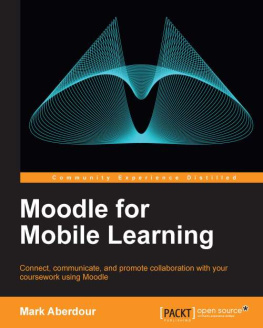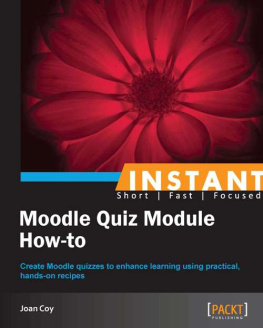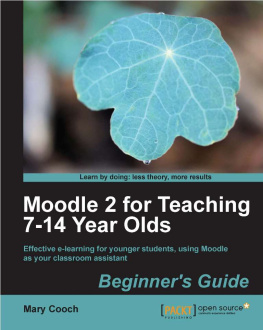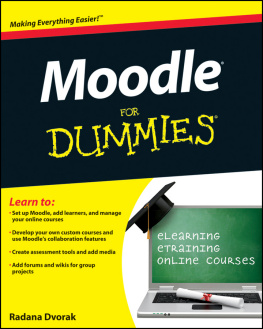This book is for people who want to teach a course using Moodle. You can use Moodle to teach a fully online course or to supplement a face-to-face course in a traditional setting. It doesnt matter if you teach at a primary school, a secondary school, in higher education, or in a corporate setting; you can use the tools and features available in Moodle to create an effective class.
The first edition of this book was written for Moodle 1.4. This second edition has been updated to cover all the features in Moodle 1.8, such as the new roles and permissions system, blogs, messaging, and the database module.
Also included in this second edition are references to the Moodle Teacher Certificate (MTC) skills. The Moodle Teacher Certificate is a way for people to demonstrate their skills in using Moodle as a teacher through a course project, a narrative document, and an online exam. The content of the certification is designed by the Moodle community, and the certification process is administered worldwide by Moodle Partners. Further details of the MTC can be found in the MTC area on Moodle.org: http://moodle.org/course/view.php?id=48.
About Us
Jason : Since were going to be spending some time together, Id better introduce myself. Ive been working in the field of educational technology for 10 years. Ive been a school district technology administrator, developed commercial web-based training, and written supplemental CDs for inclusion with textbooks. I have been involved in San Francisco State University and the Open University UKs moves to Moodle. I currently have my own instructional design and e-learning consultancy, The eLearning Hub.
Ive spent a lot of time working with teachers to incorporate technology into their classes. Ive seen what works, what doesnt, and some of the pitfalls to avoid.
Im an education geek at heart. I love living at the intersection of technology and learning theory. There are so many new and exciting opportunities in this area that I can see myself doing this for at least another 10 years.
Helen : Ten years ago I was teaching mathematics in Botswana, in a village school with hardly any educational technology!
I discovered Moodle in December 2004, when researching virtual learning environments for Alton College in the UK. I gained a great deal from the forums on Moodle.org, learning from other Moodle users experiences, and increasing my understanding by explaining things for others. I went on to implement Moodle at Alton College and also supported local schools use of Moodle.
Im now Moodle documentation steward and facilitator for the Using Moodle course on Moodle.org. Its great being a member of the worldwide Moodle community and being able to contribute to the development of such powerful educational technology.
How to Use This Book
This book is written for instructors learning how to use Moodle. Its not just a how-to manual, however. Every chapter includes suggestions, case studies, and best practices for using Moodle effectively. Using Moodle wont make your course better by itself. Only by applying effective educational practices can you truly leverage the power of Moodle.
The Moodle interface can be customized a great deal. The descriptions and screenshots in this book illustrate the default interface without any customization. If you have changed the order of the blocks in your course or if the system administrator has changed the look and feel of the main interface, your system will look different from the screenshots here.
discusses what Course Management Systems have to offer and what makes Moodle special.
gets us started using Moodle. Well sign up for an account, review the basic interface, get used to some of the conventions, and start a course.
covers how to add content to your course.
delves into course management, including understanding and using roles, arranging students into groups, and how to obtain reports of student activity.












